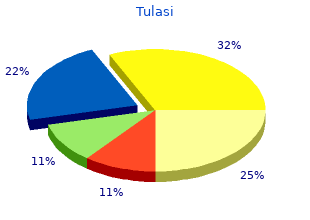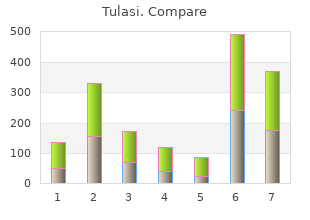Tulasi
"Purchase tulasi 60 caps with visa, herbs that help you sleep".
By: S. Norris, MD
Associate Professor, Tufts University School of Medicine
Such reactions may occur several months after therapy is started herbals in india buy 60caps tulasi overnight delivery, but laboratory abnormalities may continue to zee herbals tulasi 60caps for sale worsen for several weeks after drug is stopped herbals stock photos order 60caps tulasi fast delivery. The patient described above recovered from his liver injury, and did not require a liver transplant. Laboratory testing to determine liver enzyme levels should be done upon the first symptom or sign of liver dysfunction. Although some serious heart problems alone carry an increased risk of sudden death, atomoxetine generally should not be used in children or adolescents with known serious structural cardiac abnormalities, cardiomyopathy, serious heart rhythm abnormalities, or other serious cardiac problems that may place them at increased vulnerability to the noradrenergic effects of atomoxetine. Although the role of atomoxetine in these adult cases is also unknown, adults have a greater likelihood than children of having serious structural cardiac abnormalities, cardiomyopathy, serious heart rhythm abnormalities, coronary artery disease, or other serious cardiac problems. Consideration should be given to not treating adults with clinically significant cardiac abnormalities. Patients who develop symptoms such as exertional chest pain, unexplained syncope, or other symptoms suggestive of cardiac disease during atomoxetine treatment should undergo a prompt cardiac evaluation. It should not be used in patients with severe cardiac or vascular disorders whose condition would be expected to deteriorate if they experienced clinically important increases in blood pressure or heart rate [see Contraindications (4. The following table provides short-term, placebo-controlled clinical trial data for the proportions of patients having an increase in: diastolic blood pressure 15 mm Hg; systolic blood pressure 20 mm Hg; heart rate greater than or equal to 20 bpm, in both the pediatric and adult populations (see Table 1). In placebo-controlled registration studies involving pediatric patients, tachycardia was identified as an adverse event for 0. In placebo-controlled registration studies involving adult patients, tachycardia was identified as an adverse event for 1. If such symptoms occur, consideration should be given to a possible causal role of atomoxetine, and discontinuation of treatment should be considered. In a pooled analysis of multiple short-term, placebo-controlled studies, such symptoms occurred in about 0. Two adult atomoxetine subjects and no placebo subjects discontinued from controlled clinical trials because of urinary retention. A complaint of urinary retention or urinary hesitancy should be considered potentially related to atomoxetine. Patients who were pre-pubertal at the start of treatment (girls 8 years old, boys 9 years old) gained an average of 2. Patients who were pubertal (girls >8 to 13 years old, boys >9 to 14 years old) or late pubertal (girls >13 years old, boys >14 years old) had average weight and height gains that were close to or exceeded those predicted after three years of treatment. Child and Adolescent Clinical Trials Reasons for discontinuation of treatment due to adverse reactions in child and adolescent clinical trials � In acute child and adolescent placebo-controlled trials, 3. The following reactions did not meet this criterion but were reported by more atomoxetine-treated patients than placebo-treated patients and are possibly related to atomoxetine treatment: blood pressure increased, early morning awakening (terminal insomnia), flushing, mydriasis, sinus tachycardia, asthenia, palpitations, mood swings, constipation, and dyspepsia. The following reactions were reported by at least 2% of patients treated with atomoxetine, and equal to or less than placebo: pharyngolaryngeal pain, insomnia (insomnia includes the terms, insomnia, initial insomnia, middle insomnia). The following reaction did not meet this criterion but shows a statistically significant dose relationship: pruritus. Adult Clinical Trials Reasons for discontinuation of treatment due to adverse reactions in acute adult placebo-controlled trials � In the acute adult placebo-controlled trials, 11. In these clinical trials, no poor metabolizers (0/43) reported seizures compared to 0. The following reactions did not meet this criterion but were reported by more atomoxetine-treated patients than placebo-treated patients and are possibly related to atomoxetine treatment: peripheral coldness, tachycardia, prostatitis, testicular pain, orgasm abnormal, flatulence, asthenia, feeling cold, muscle spasm, dysgeusia, agitation, restlessness, micturition urgency, pollakiuria, pruritus, urticaria, flushing, tremor, menstruation irregular, rash, and urinary retention. Male and female sexual dysfunction � Atomoxetine appears to impair sexual function in some patients. Changes in sexual desire, sexual performance, and sexual satisfaction are not well assessed in most clinical trials because they need special attention and because patients and physicians may be reluctant to discuss them. Accordingly, estimates of the incidence of untoward sexual experience and performance cited in product labeling are likely to underestimate the actual incidence. Unless otherwise specified, these adverse reactions have occurred in adults and children and adolescents. Nervous system disorders � Hypoaesthesia; paraesthesia in children and adolescents; sensory disturbances; tics.

It is important to herbals for ed purchase tulasi paypal continued for another 7 to herbs urinary tract infection buy generic tulasi canada 14 days at the same remember that topical steroids are systemically or a decreased dose or is discontinued herbals for hair loss cheap tulasi 60 caps on line. The effect of otic vehicle and concentration on cytological examination and microbial growth density on culture of dexamethasone on liver enzyme activities and adrenal function in of swabs from the external ear canal in dogs. Organisms will be characterized or identified depending on the nature of the culture. If anaerobes are suspected as a cause of chronic otitis media, specifically request an Anaerobic Culture. Special Instructions: Specimen site and date/time of collection are required for specimen processing. Specimen Specimen Type: Aspirate (tympanocentesis) for otitis media; moist swab for otitis externa. In cases of otitis media in which the eardrum has ruptured, a swab may be used to collect the exudates. For intact eardrum, clean ear canal with soap solution and collect fluid via syringe aspiration technique. For ruptured eardrum, collect fluid on flexible shaft swab via an auditory speculum. For otitis externa, vigorous swabbing is required since surface swabbing may miss streptococcal cellulitis. Transport/Storage: Onsite collections: Transport to the Microbiology Laboratory immediately. Specimens must be promptly transported to the laboratory, with the next available courier, not to exceed 24 hours from the time of collection. Sample Rejection: Improperly labeled specimen; specimens with prolonged transit time (see Transport/Storage for requirements); specimen not submitted in appropriate transport container; insufficient volume; external contamination. If an unacceptable specimen is received, the physician or nursing station will be notified and another specimen will be requested before the specimen is discarded. Limitations: Results for throat or nasopharyngeal swab cultures are not predictive of agents responsible for otitis media and should not be submitted for that reason. Methodology: Aerobic culture Additional Information: A number of microbial species populate the skin of the healthy ear including Staphylococcus epidermidis, Corynebacterium, and Micrococcus. Otitis media (middle ear infections) in children is usually caused by pneumococci, H. Chronic otitis media yields predominately anaerobic flora and less commonly present are S. Summary Aim: To describe the bacterial and fungal organisms in otitis externa patients without other risk factors for fungal infections. Conclusion: Fungal organisms especially Candida species may be isolated from ears of otitis externa patients without fungal infection risk factors such as ear self-cleaning, local antimicrobial, antifungal or corticosteroid drops or systemic antimicrobial or antifungal agents within the preceding week. Bacterial and fungal cultures may be recommended, and anti-fungal agents may be added, to treatment regimens in patients with otitis externa. For anaerobes, the material antibiotics and increased use of topical fluoroquinolone2 was inoculated within 60 minutes into thioglycolate broth antibiotics3-6. Standard microbiological technique was used in diagnosis Our study aimed to investigate the bacterial and of isolates. The distribution of isolates in culture There were 124 males and 238 females with ages ranging positive cases is summarized in Table I. Fungal discharge (scanty white mucoid, grey, bluish-green and agents were found in 9. The patients with diagnosed by resident between Staphylococcus aureus, Pseudomonas aeroginosa, otolaryngologist (single observer) as fungal infection of Candida sp. Although the ear canal with shows very characteristic findings such bacterial agents isolated were compatible with the literatu as black or white mass of the fungus (spores or hyphae of re, Candida species were the most common fungal agents. Demographic Staphylococcus aureus is cited as the most common causa data, history, symptoms and predisposing factors were tive infectious agent and fungi are occasional pathogens9 recorded for each patient. Three specimens each of the affected external gal infections, it has been observed that systemic or local canal were obtained with three separate sterile cotton swa immunosuppression, exogenous materials (tympanostomy bs with precautions taken to avoid contact with the cavum tubes), and systemic or local antibiotic treatment can serve Brazilian Journal of otorhinolaryngology 75 (5) SeptemBer/octoBer 2009. It is more commonly (25%) were the most outstanding predisposing factors for found in temperate zones while Aspergillus niger is more otomycosis. Thus, Otorrhea due to fungal organisms especially Can positive culture of the Candida species does not always dida species must be kept in mind as a possible causative mean that Candida is the pathogen of the otitis externa agent in otitis externa patients without risk factors for therefore; our study cannot differentiate between fungal fungal infection.
Cheap tulasi 60caps without prescription. Newlife Natural 100% Herbal Products and their Healing and health Benefits.

Syndromes
- Speedball: Mixing with heroin and injecting into a vein
- You have shortness of breath while talking
- Limbitrol
- Certain types of cancer
- Slight vaginal discharge
- Eat more fiber, which can be found in fruits, vegetables, beans, whole grain products, and nuts.
- Missing meals
- Aggressive behavior when woken uip by someone else
- Aortography

